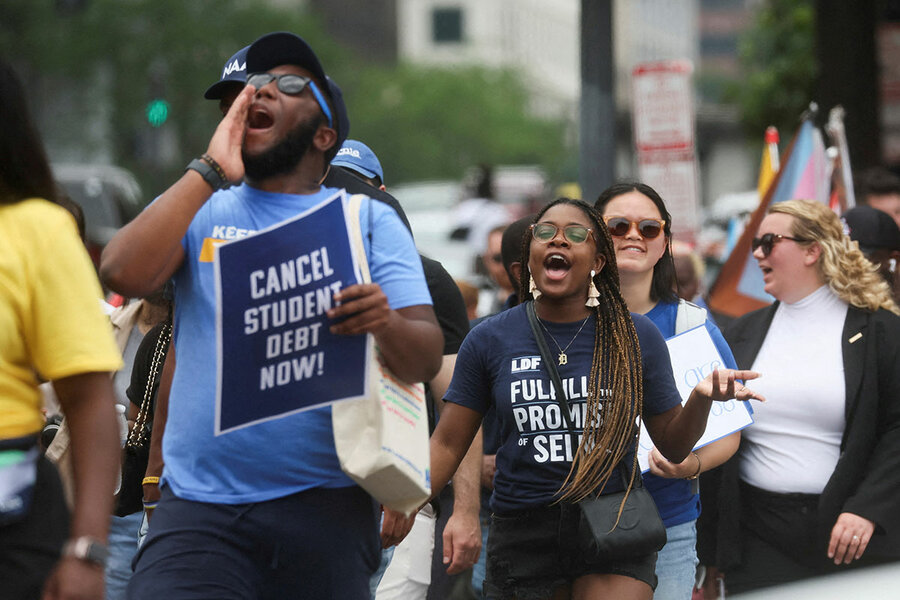Student loans: How a new White House forgiveness plan works
Loading...
A week ago, 74,000 Americans got some unexpected news: Their student loans – totaling nearly $5 billion – had been forgiven by the White House. Some 44,000 of those people were police officers, nurses, and firefighters, entitled to relief after 10 years of public service.
As of this month, the Biden-Harris administration says, it has approved $137 billion in loan forgiveness for more than 3.7 million people. Starting next month, enhancements to a program launched in August will go into effect and will have an impact on almost 7 million more people. While that’s still far short of the number covered under President Joe Biden’s initial $430 billion loan forgiveness plan, supporters say it is the most generous plan implemented to date.
“I would say it is one of the signature accomplishments of the Biden-Harris administration in terms of higher education affordability,” says Sara Partridge, a senior policy analyst for the Center for American Progress. These repayment plans “can be a little wonky and complicated, so I think what’s really major about it can be lost in the details,” Dr. Partridge adds.
Why We Wrote This
The Biden administration is forgiving the college debt of thousands of Americans, including nurses and firefighters. What does the latest plan entail?
Didn’t the Supreme Court kill student loan relief? What happened?
President Biden campaigned on a broad promise of student debt relief for millions of Americans. His administration offered $10,000 per borrower in debt forgiveness, plus an additional $10,000 for those with lower incomes. The Supreme Court of the United States struck down that program in 2023. The justices ruled that the secretary of education did not have authority under the pandemic-era HEROES Act to cancel student loan debt and that “the economic and political significance of the secretary’s action is staggering by any measure.”
The Biden-Harris administration then pivoted to enhancing existing loan forgiveness programs. President Biden’s most ambitious student loan relief program, the Saving on a Valuable Education (SAVE) plan, currently has about 7 million borrowers signed up for forgiveness.
What is the SAVE program?
The SAVE program started this past August. Like earlier plans, it uses income and family size to determine borrowers’ monthly payments.
Old programs considered income above 150% of the federal poverty level to be discretionary income. SAVE considers anything above 225%. If a borrower is single and makes less than $15 an hour, or less than $32,800 annually, they will pay $0 a month, as long as the person’s salary remains the same. Single borrowers who make $60,000 would pay a maximum $227 a month. Estimates are that annual average savings will be $1,080 for single borrowers and $2,244 for families of four.
Perhaps the biggest change is that, unlike with earlier programs, borrowers won’t see their interest payments balloon – sometimes to thousands above the original loan amount. With SAVE, the government pays all interest costs not included in the monthly payment. In earlier income-driven repayment (IDR) plans, the government would cover half of the interest owed.
“This was a big problem before. You had these balances, and you’re like, ‘OK, well, this is affordable, but I’m not actually paying off my debt, and the debt is ballooning,’” says Persis Yu, deputy executive director and managing counsel at the Student Borrower Protection Center. Ms. Yu says compounding interest was a disincentive for potential program participants.
What happens next month?
In February, a 10-year repayment option is going into effect, six months earlier than expected. SAVE allows participants who initially borrowed less than $12,000 to be forgiven after 10 years of payments. Traditional IDR payment plans were scheduled to be complete in 20 to 25 years.
For every $1,000 borrowed above $12,000, the SAVE repayment term is increased by a year (capped at 20 years for undergraduate loans, for example). So say someone borrowed $15,000. They would be fully forgiven after 13 years of payments.
Starting in summer 2024, most borrowers will have their monthly payments reduced. Currently, IDR programs set monthly payments at 10% of discretionary income. For borrowers who have undergraduate loans, the percentage will fall to 5%. Borrowers with loans from graduate school will still have to pay 10%.
The U.S. Department of Education has made certifying income for borrowers less cumbersome with an agreement with the IRS that allows for recertification to be done automatically, with borrowers’ permission. Under previous programs, borrowers had to prove their income annually. Many were disqualified because service providers didn’t tell them this stipulation.
Will court cases be coming for SAVE?
In December, Congress tried to block implementation of SAVE with the Congressional Review Act, arguing that it was expensive and unfairly shifted the cost of college from borrowers to taxpayers. The Democratic-controlled Senate fell short of the votes to pass the act.
Dr. Partridge, at the Center for American Progress, says what makes SAVE and other measures more likely to stand up in court is that they are iterations of programs that started many years ago. IDRs, which started in the 1990s, were created by Congress. The act that created Public Service Loan Forgiveness also was passed by Congress in 2007.
“We haven’t seen any [court] challenges to the SAVE program right now. And then with IDR plans, really what the Biden administration has done there is very in line with established practice,” Dr. Partridge says.
If President Biden loses reelection, a new administration could come in and choose to sunset the program, she says. People who already received benefits would not see those benefits rolled back, Dr. Partridge adds.
Ms. Yu agrees it would be hard to overturn SAVE.
“It’s very challenging to take away an existing right,” she says, adding that student loans are a recognized contract with the government.
“Student loans are different from other kinds of government programs. Once you recognize the term of the contract, you have a promissory note, just like any other loan,” she explains. “Congress or the courts coming in and then changing that contract is legally trickier.”






